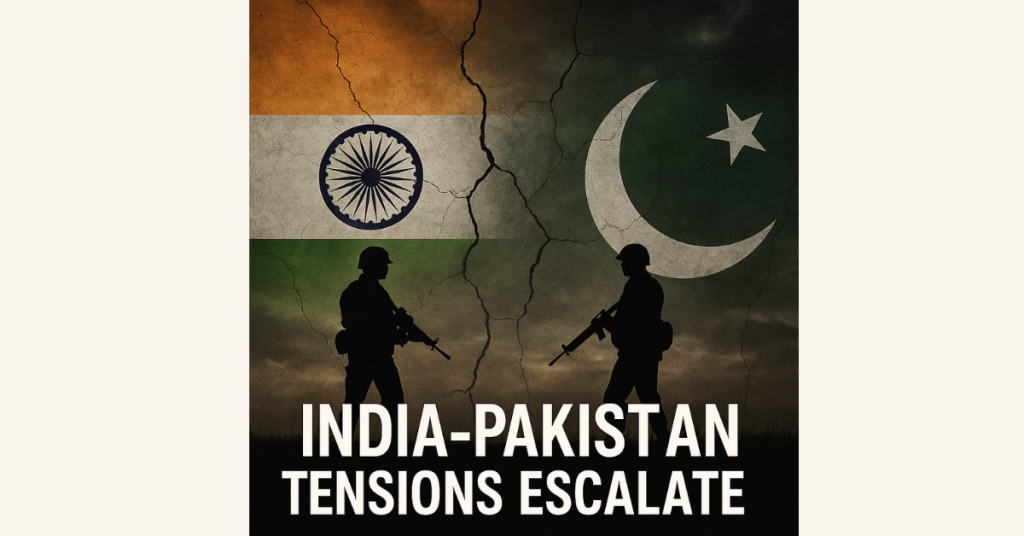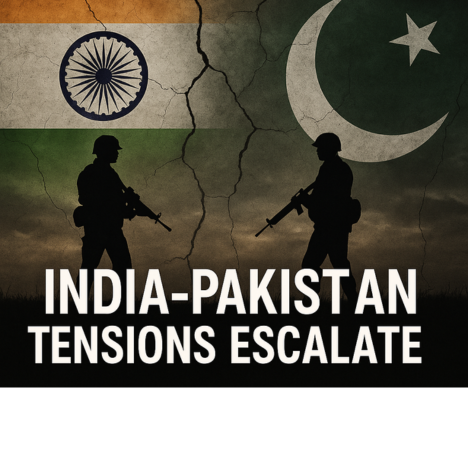Introduction
In a troubling development for South Asia and the broader international community, recent events have led to a significant escalation in tensions between India and Pakistan. With reports of cross-border skirmishes, political statements, and military posturing dominating headlines, concerns about a potential full-scale conflict are rising. Although both nations have a long history of complex relations, the current climate has reignited fears of war between the nuclear-armed neighbors.
Historical Background of India-Pakistan Conflict

The rivalry between India and Pakistan dates back to 1947, when British India was partitioned into two independent nations. The root cause of conflict has often been centered on the disputed region of Jammu and Kashmir, over which both countries claim full sovereignty.
Since independence, India and Pakistan have fought three major wars (in 1947, 1965, and 1971) and engaged in a limited conflict in Kargil in 1999. The two nations have also experienced numerous smaller skirmishes and ceasefire violations along the Line of Control (LoC) — the de facto border in Kashmir.
Current Developments: What’s Happening Now?
In the last two weeks, multiple incidents along the LoC have been reported, involving cross-border shelling, drone activity, and heightened troop movements. On [insert exact date if known], the Indian Ministry of Defence released a statement alleging “unprovoked firing” by Pakistani forces in the Poonch and Rajouri sectors of Jammu and Kashmir.
In response, Pakistan’s military spokesperson accused Indian forces of initiating aggression and violating the 2003 ceasefire agreement. While casualty figures remain unconfirmed, unofficial sources suggest civilian injuries and military losses on both sides.
In a parallel development, both countries have heightened their diplomatic rhetoric, accusing each other of destabilizing the region. India has called for an international inquiry into alleged cross-border infiltration attempts, while Pakistan has submitted a formal complaint to the United Nations regarding what it calls “Indian war provocations.”
Key Trigger Points of the Current Escalation
Several factors appear to have contributed to the recent surge in hostilities:
- Militant Activity in Kashmir: India claims that insurgent groups backed by Pakistan are attempting to enter Indian-administered Kashmir. Pakistan denies this and argues that India is using these accusations to justify military aggression.
- Domestic Political Pressures: Both Indian and Pakistani governments face internal challenges — including elections, economic concerns, and public dissatisfaction — which analysts suggest could influence a more aggressive foreign policy stance.
- Geopolitical Shifts: The changing dynamics in South Asia, including China’s growing regional influence and the Taliban’s return in Afghanistan, may also be altering the strategic calculations of both nations.
The Risk of War: How Likely Is It?
Despite the alarming signs, military experts believe that a full-scale war remains unlikely, though not impossible. Both India and Pakistan are nuclear powers, and any escalation beyond conventional warfare would carry catastrophic consequences not only for South Asia but for global stability.
However, the risk of miscalculation or accidental escalation remains high, especially amid heightened emotions and rapid military mobilization. Incidents like the Balakot airstrikes in 2019 and the subsequent aerial dogfight demonstrate how quickly tensions can spiral out of control.
International Reactions and Diplomatic Calls for Restraint
The international community has been quick to respond. The United Nations, United States, China, and European Union have all issued statements urging both India and Pakistan to exercise restraint and seek dialogue.
- The United Nations Secretary-General expressed “deep concern” over the recent border incidents and called for both countries to resolve their differences through peaceful means.
- U.S. State Department spokesperson said Washington is closely monitoring the situation and is in contact with both governments to encourage de-escalation.
- China, which shares borders with both India and Pakistan, has urged diplomatic engagement while reiterating the importance of regional stability.
Civilian Impact and Humanitarian Concerns
As always, civilians living in border areas are the most affected. Hundreds of families in Jammu and Kashmir have reportedly been displaced due to shelling. Schools have been shut down, and emergency shelters are being set up by local authorities.
Human rights organizations are also warning about a potential humanitarian crisis if the situation deteriorates. Access to essential services like healthcare, food, and electricity has already been disrupted in some regions near the LoC.
Role of Media and Misinformation
In both India and Pakistan, mainstream and social media are playing a significant role in shaping public opinion. Unfortunately, this has also led to the rapid spread of unverified information, propaganda, and nationalist rhetoric.
Authorities in both countries are urging media outlets to verify facts before dissemination. Analysts caution that misinformation can worsen tensions and reduce the space for diplomatic dialogue.
What Happens Next?
At the moment, both governments seem unwilling to back down publicly, but behind-the-scenes diplomatic channels may still be active. The coming days will be critical in determining whether this standoff will cool off or escalate further.
Possible outcomes include:
- Renewed back-channel diplomacy between intelligence agencies
- A joint statement or ceasefire reaffirmation
- Third-party mediation or involvement from international bodies like the UN
Ultimately, a peaceful resolution depends on the political will of both nations and the pressure exerted by the global community.
Conclusion
The India-Pakistan conflict remains one of the world’s most enduring and dangerous rivalries. The current escalation serves as a stark reminder of how fragile peace can be in the region. As border tensions rise, the world watches closely, hoping that diplomacy will prevail over war.









Leave a Reply